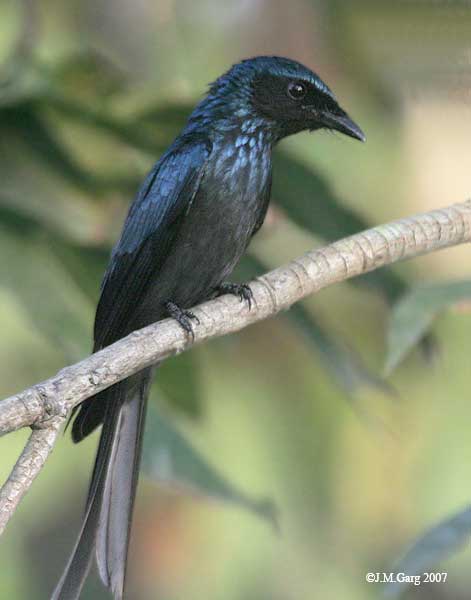Dicrurus aeneus (*) Cladus: Eukaryota Name Dicrurus aeneus Vieillot, 1817 Vernacular names
Nouveau Dictionnaire d'Histoire Naturelle Appliquée Aux Arts, principalement à l'Agriculture et à l'Economie rurale et domestique par une société de naturalistes et d'agriculteurs, avec des figures tirées des trois règnes de la nature. 9 p.586 The Bronzed Drongo (Dicrurus aeneus) is a small Indomalayan bird belonging to the drongo group. They are resident in the forests of South Asia and Southeast Asia. They are very similar to the other drongos of the region but are somewhat smaller and compact with differences in the fork depth and the patterns of gloss on their feathers.
This drongo is somewhat smaller than the Black Drongo and has more metallic gloss with a spangled appearance on the head, neck and breast. The lores are velvety and the ear coverts are duller. The tail is slender and well forked with the outer tail feathers flaring outward slightly. Immatures have their axillaries tipped in white.[2] The young bird is duller and brownish with less spangling.[3] The nominate race is found in India and extending until the northern part of the Malay Peninsula. Specimens from southern India are however very similar in morphometrics to those from malayensis of Burma and the size variation may be clinal. The subspecies from China kwangsiensis is treated as synonymous with aeneus. Subspecies malayensis is found from Selangor south into, Sumatra and Borneo. Taiwan is home to braunianus in the mountains of the interior.[2][4] Distribution The Bronzed Drongo is found in the Western Ghats and Eastern Ghats of India and the lower Himalayas from western Uttaranchal eastwards into Indochina int Hainan, the Malay Peninsula, Sumatra and northern Borneo. This species is usually found in moist broadleaved forest.[2][5] Behaviour and ecology They are found singly or in a group of two to three. They very actively make aerial sallies and make use of the same favourite perches.[3] The breeding season is February to July. Three or four pinkish to brownish eggs are laid in a cup nest in a tree. The eggs are darker on the broad end and often have cloudy spots. The nest is covered in cobwebs and often appears whitish.[5] These are aggressive and fearless birds, 24 cm in length, and will attack much larger species if their nest or young are threatened.[6] References 1. ^ BirdLife International (2009). Dicrurus aeneus. In: IUCN 2009. IUCN Red List of Threatened Species. Downloaded on 8 April 2009. Source: Wikipedia, Wikispecies: All text is available under the terms of the GNU Free Documentation License |
|

